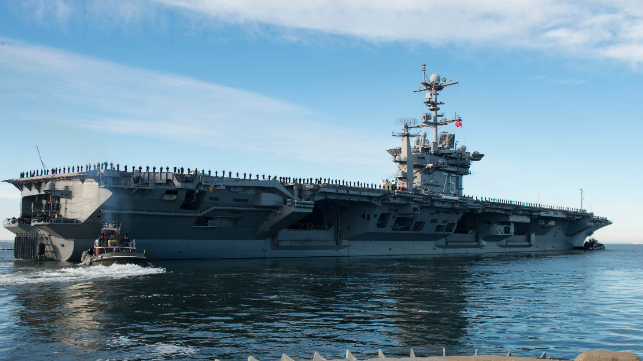USS Harry S. Truman Returns From COVID-19 Extended Deployment

The Nimitz-class carrier USS Harry S. Truman returned to its homeport at Naval Station Norfolk after a deployment that was extended due to the treat of the coronavirus. During the extended voyage, she operated in the U.S. 2nd, 5th, and 6th Fleets and her return marks the final homecoming for the strike group.
According to the U.S. Navy, the Truman has spent at least one day underway for 32 of the last 36 months. The carrier departed on her scheduled voyage on November 18, 2019, but following a return from deployment in March after operating in the U.S. 5th and 6th Fleet, due to the spread of the coronavirus, the Navy ordered her to continued operations underway minimizing the potential spread of the virus aboard the ship.
The Truman remained underway in the Western Atlantic during the sustainment phase of the Optimized Fleet Response Plan cycle as a certified and ready carrier force, ready for tasking. As a result of the extended deployment, the Truman sailed over 56,000 nautical miles. The ship also completed multiple straits and choke-point transits, including the Strait of Gibraltar, the Suez Canal, and the Bab-el Mandeb Strait, while operating under three combatant commanders.
“I’m so very proud of all our Sailors!” said Capt. Kavon Hakimzadeh, commanding officer of the Truman. “Their resilience, perseverance, and utter dedication to mission has been nothing short of exemplary. It has been my greatest honor to serve as Truman’s commanding officer this deployment!”
Throughout the deployment, Truman performed numerous training exercises to develop tactical competencies. From carrier strike force operations as the flagship of the Harry S. Truman Carrier Strike Group (HSTCSG) to exercises with partner navies and forces, the ship developed key skillsets to maintain readiness and interoperability. For example, in the Western Atlantic, the HSTCSG conducted a week of naval air integration exercises with Marine Corps elements assigned to the 2nd Marine Aircraft Wing (2nd MAW).
The Truman concluded operations underway by participating in a U.S. Northern Command-led exercise Vigilant Osprey, a major service-integrated homeland defense exercise aimed to strengthen operational partnerships alongside forces from Canada, Denmark, and the U.S. Air Force. The joint, multi-domain operations with Allies in the Atlantic Ocean, demonstrated North American Aerospace Defense Command’s ability to defend Canada and the U.S.
Secretary of the Navy Kenneth J. Braithwaite visited the Truman on June 4 and during his first official trip since taking the oath of office as the secretary of the Navy May 29, announced that the strike group would be returning home by mid-June. Elements of the Harry S. Truman Carrier Strike Group began returning home on June 5, marking the end of their deployment after operating in the 2nd, 4th, 5th and 6th Fleet areas of operation. The Truman completed necessary maintenance underway before her return to base.
In March 2019, the U.S. Navy had informed Congress of a plan to remove the Truman from the fleet in 2024. The decision would have avoided her mid-life Refueling and Complex Overhaul (RCOH), and would have saved about $3.4 billion over five years - and up to $30 billion over the span of her remaining life. The decommissioning proposal, however, was unpopular in Congress and in May Vice President Mike Pence announced that the president had decided to keep the supercarrier operational.
